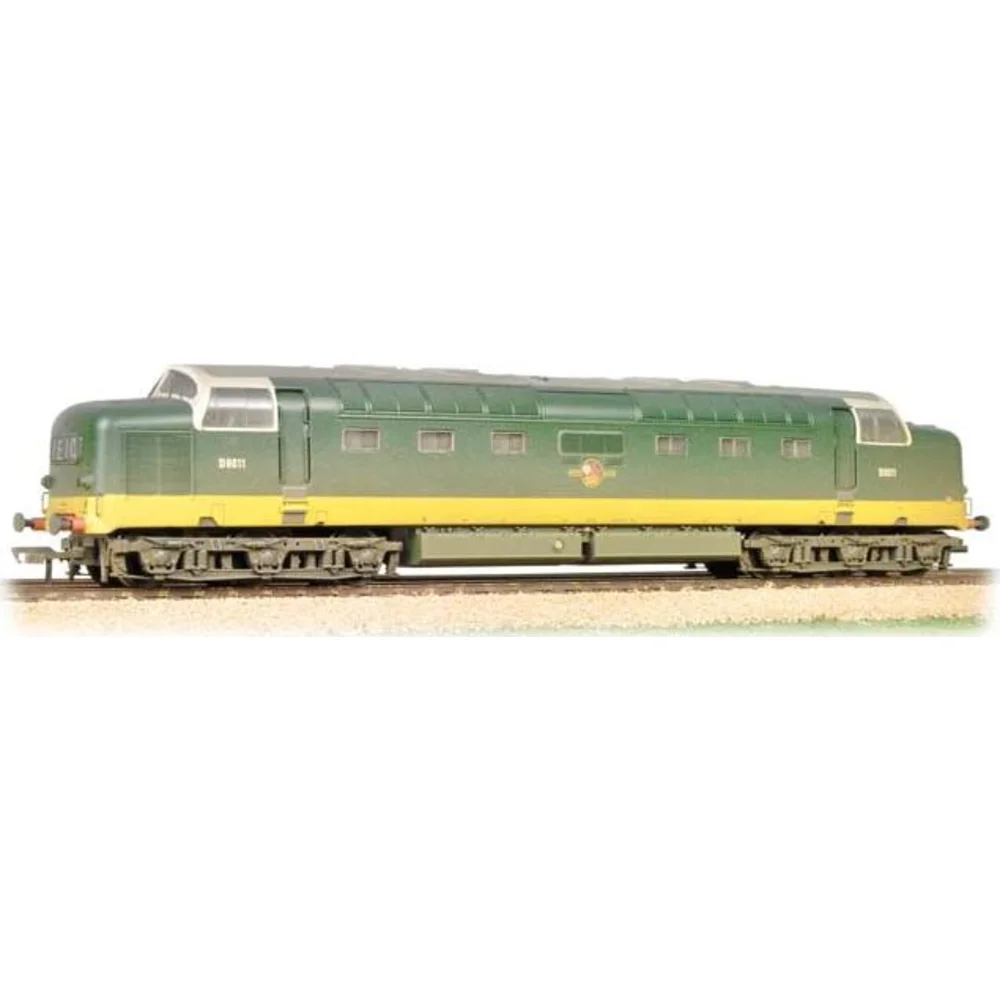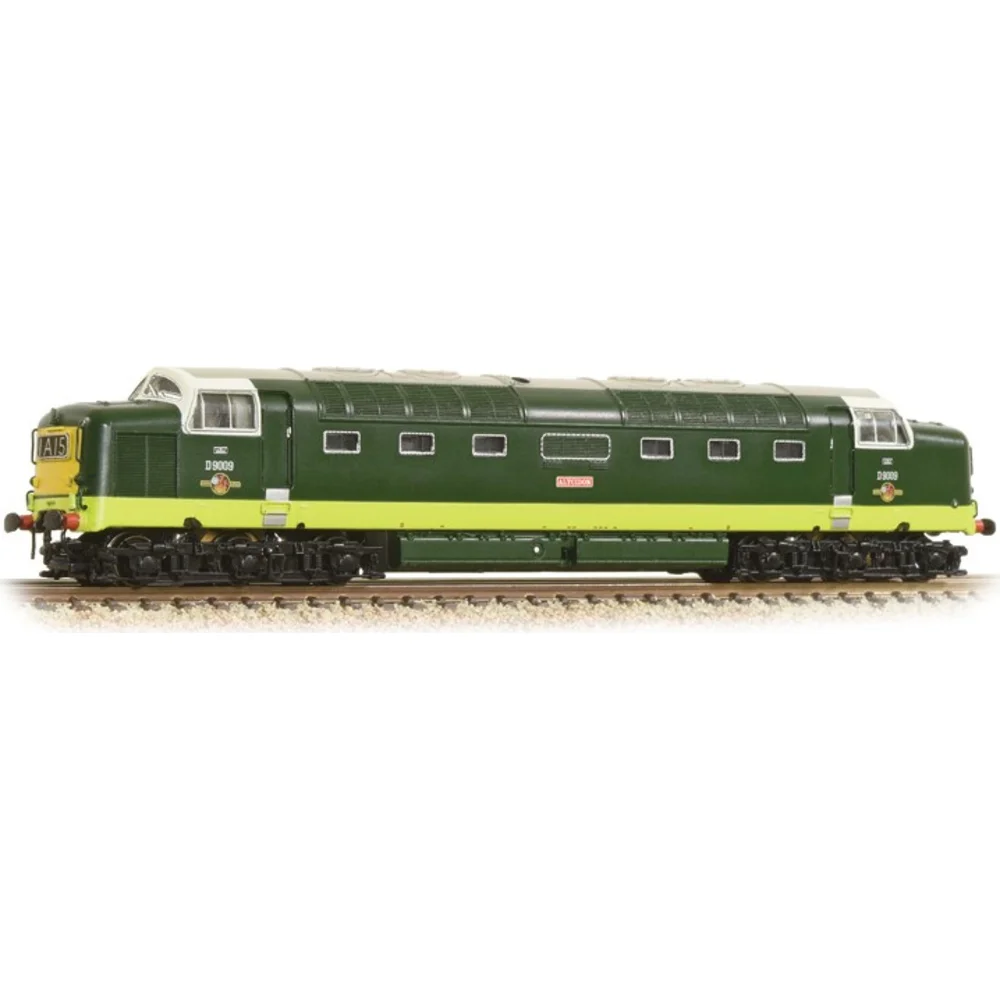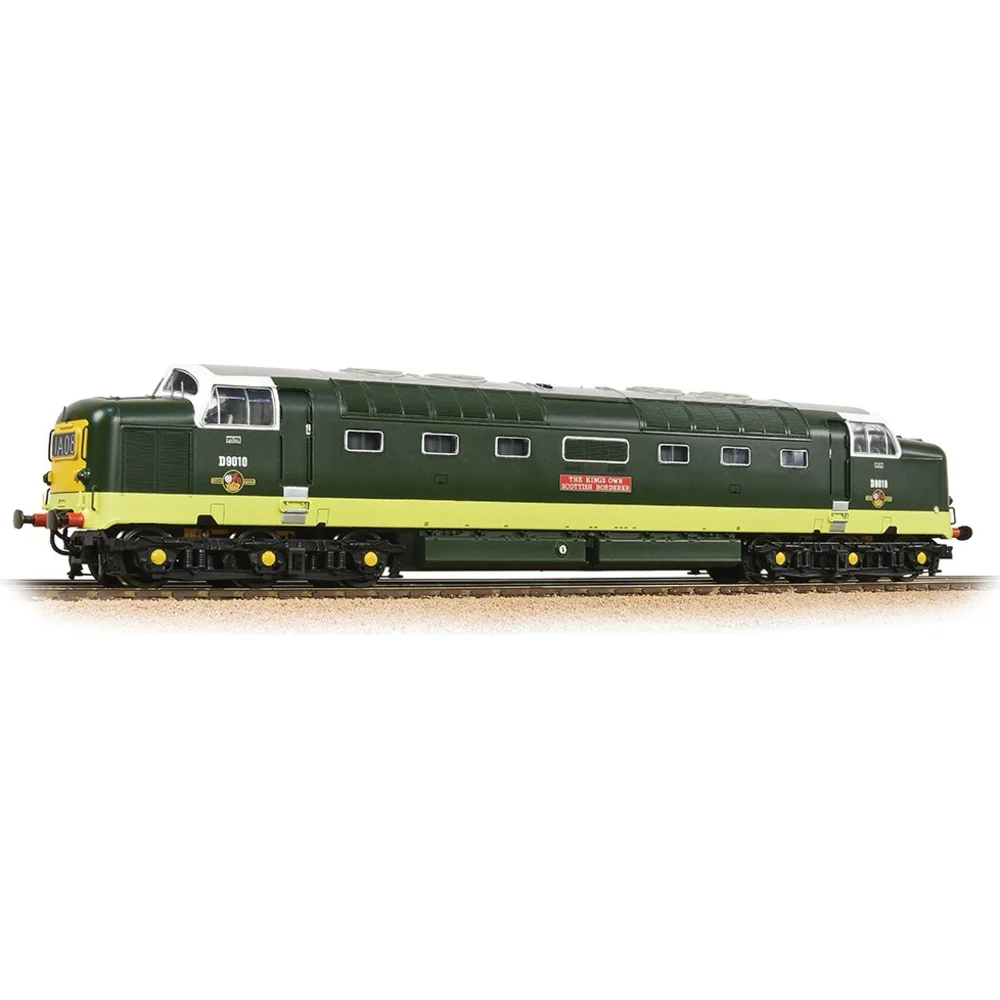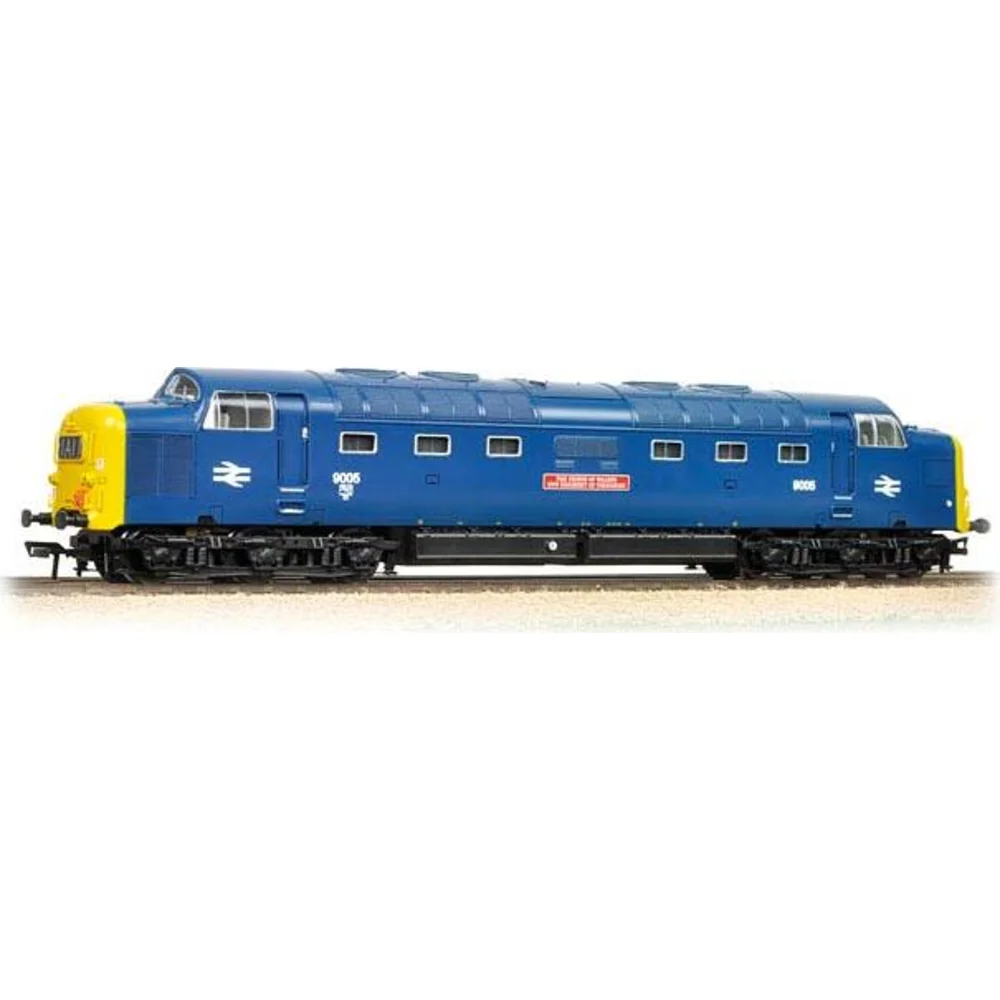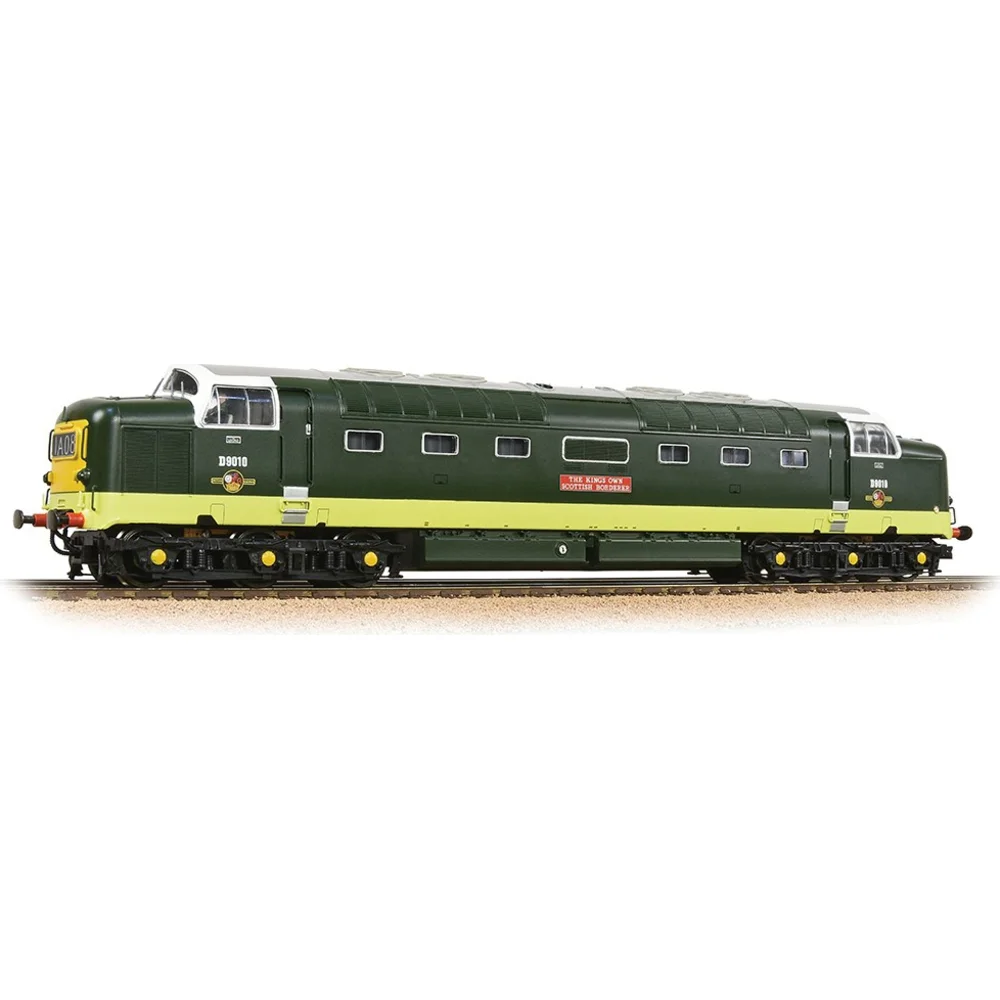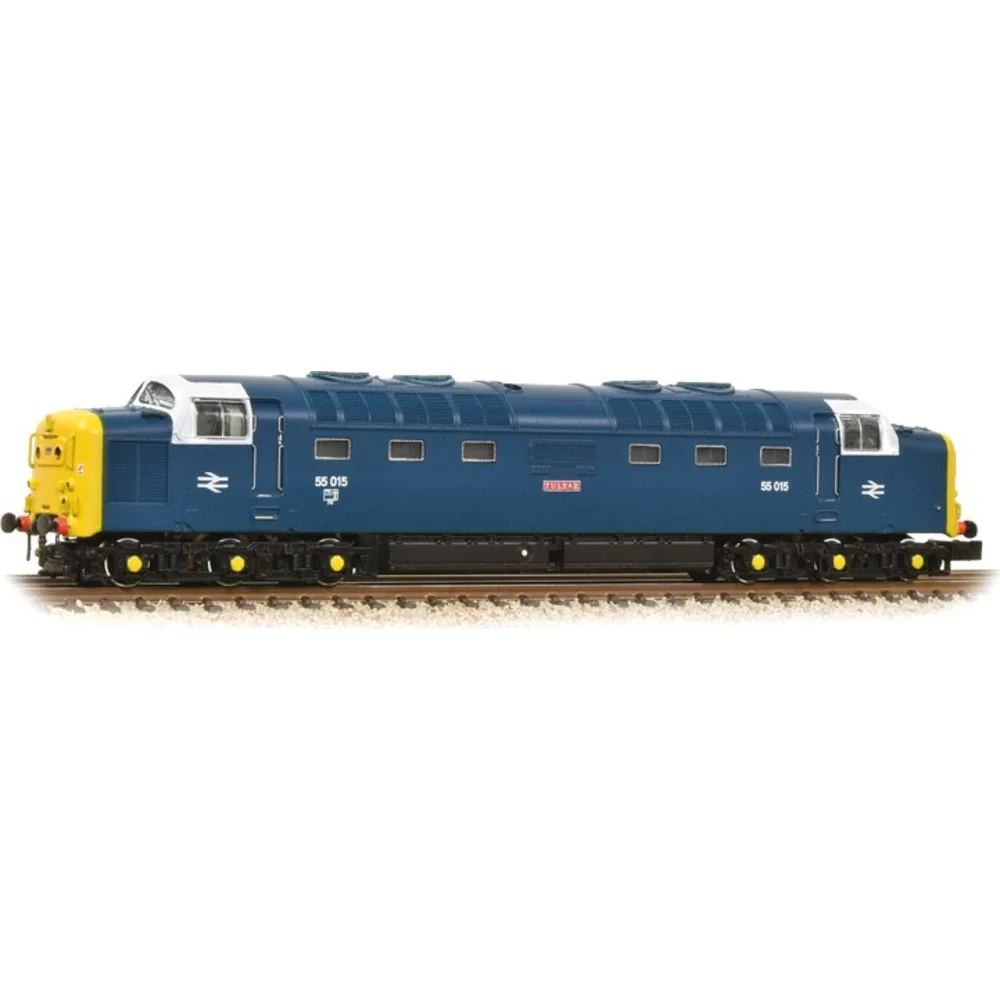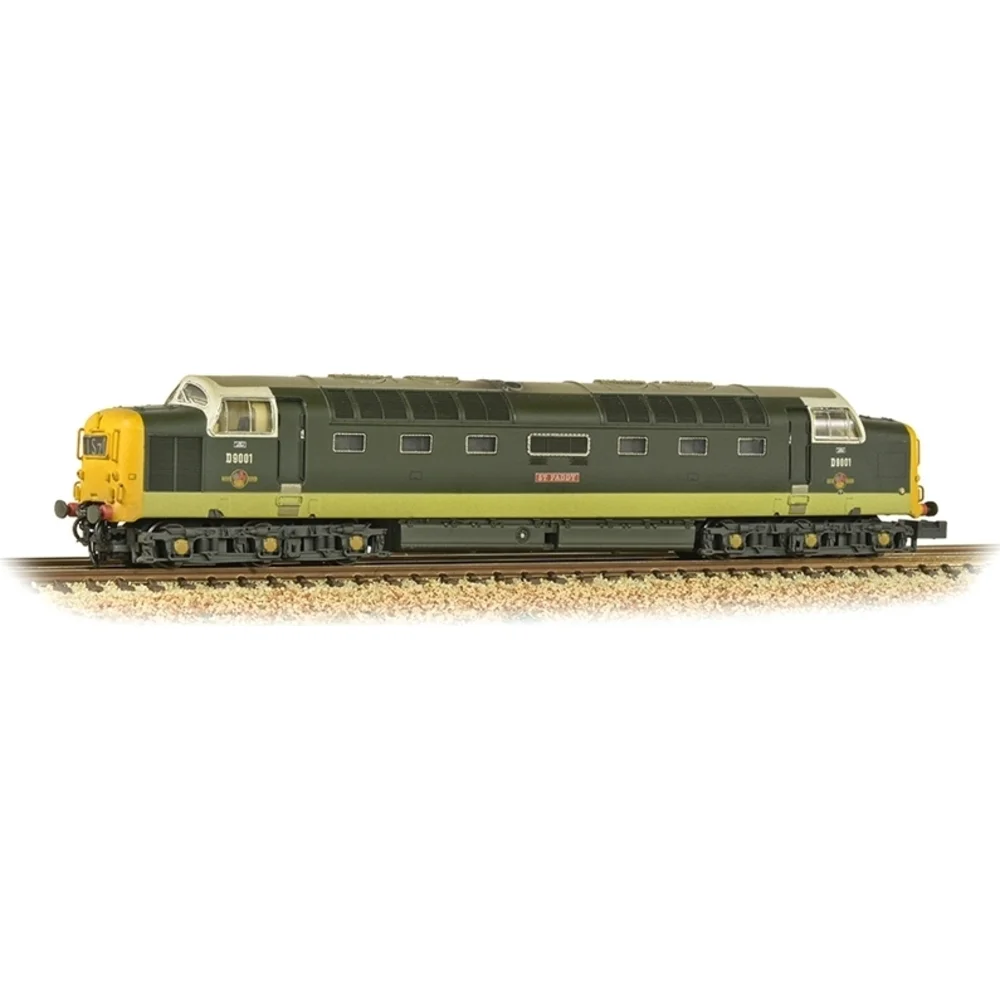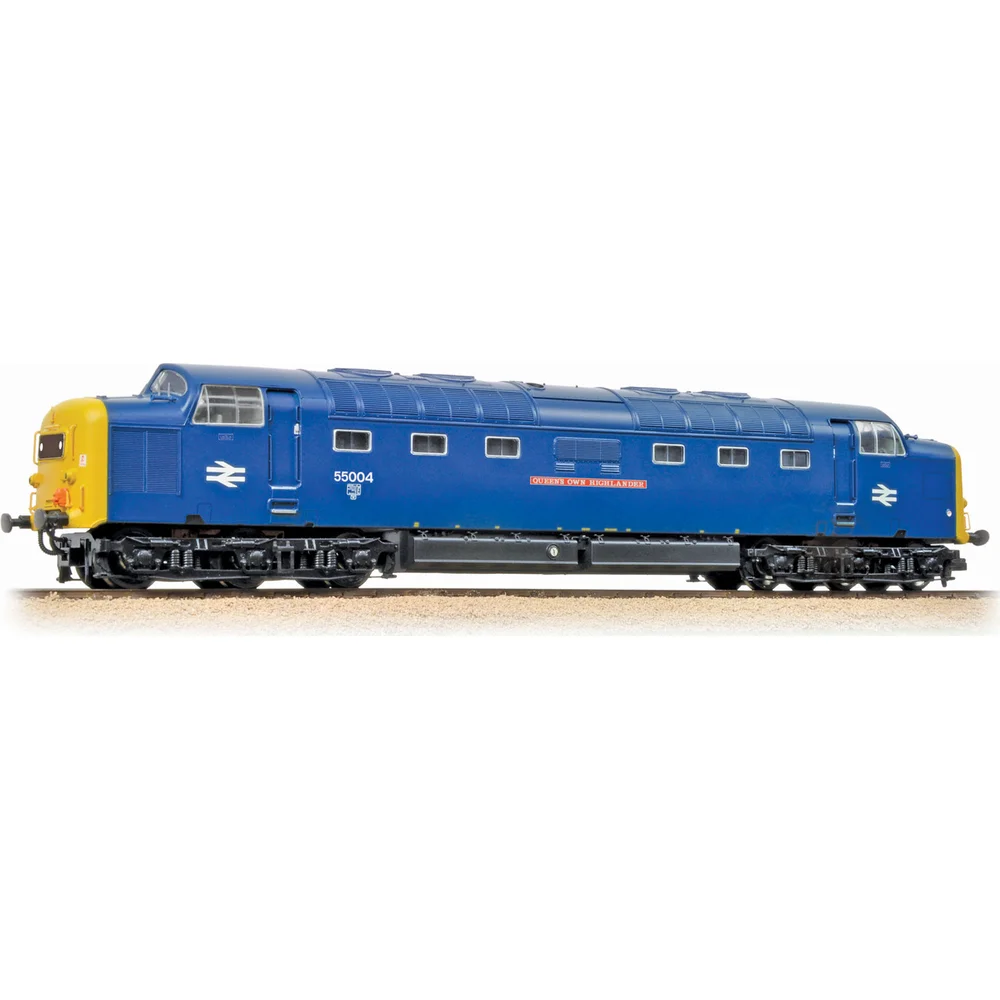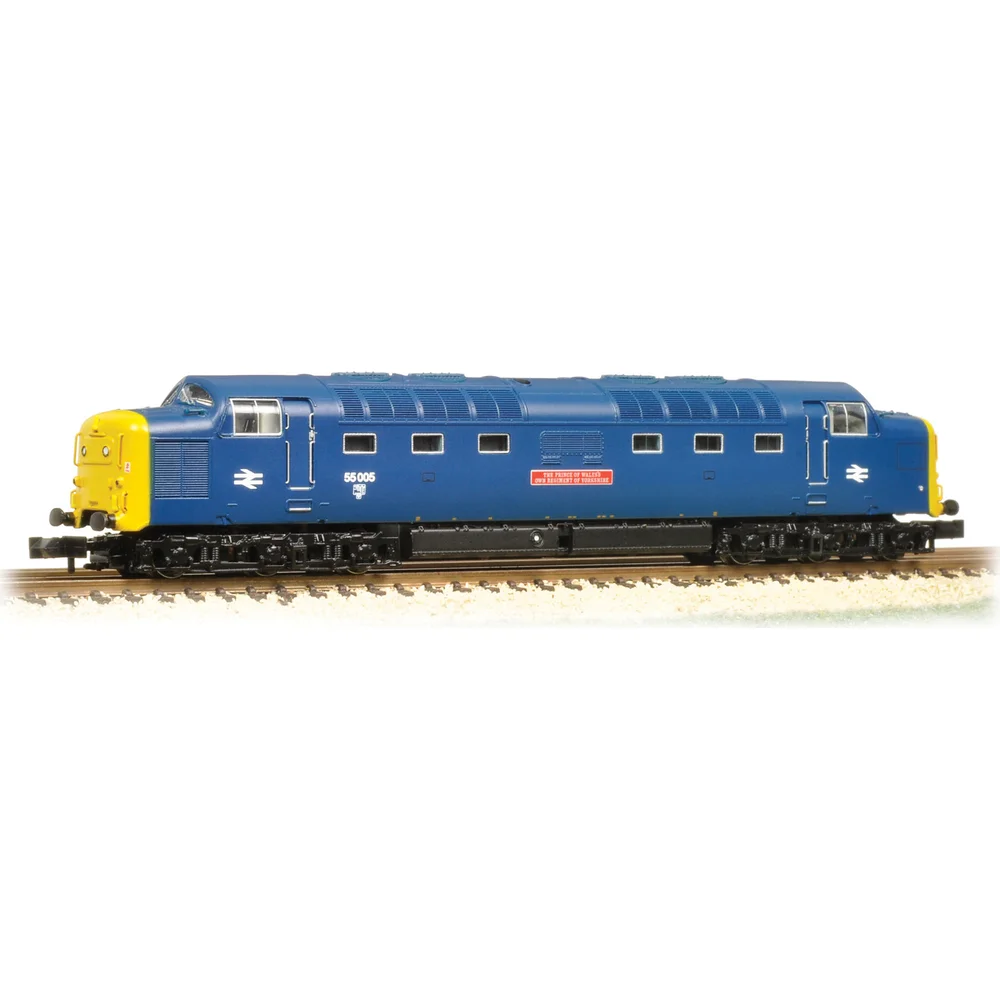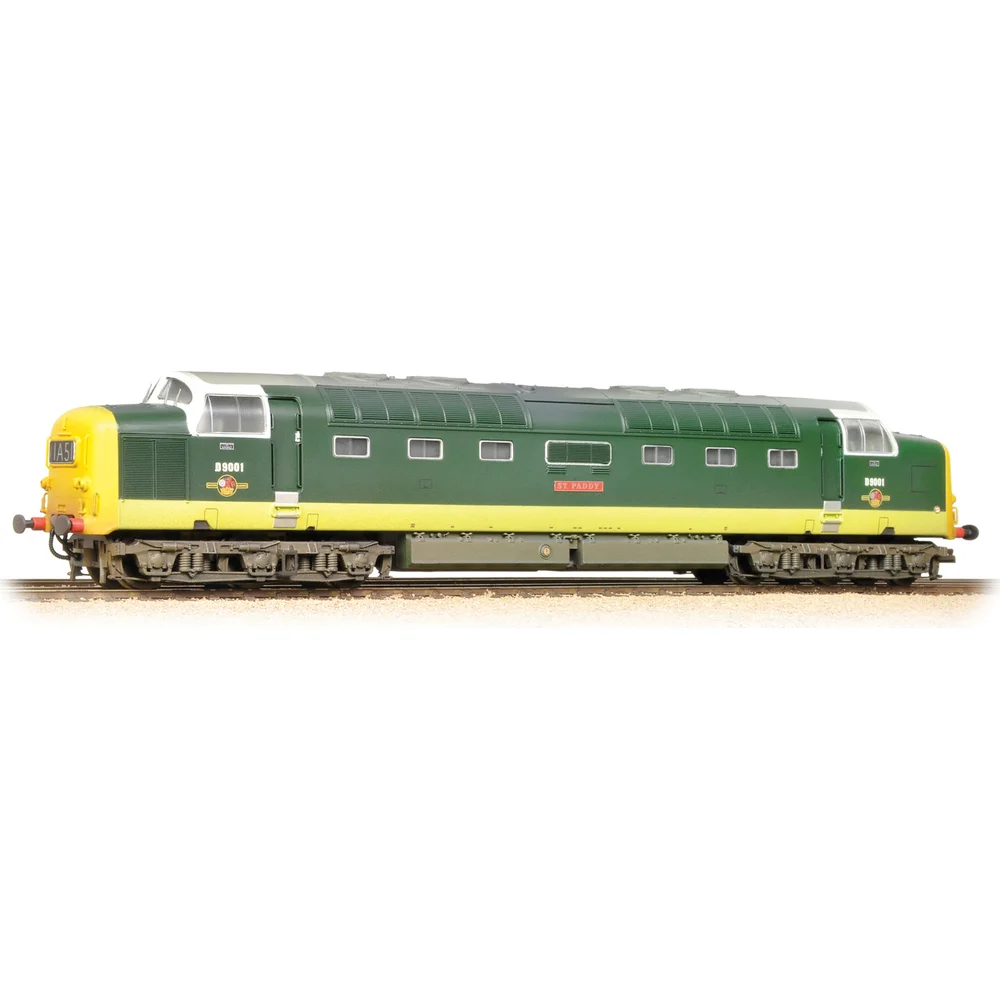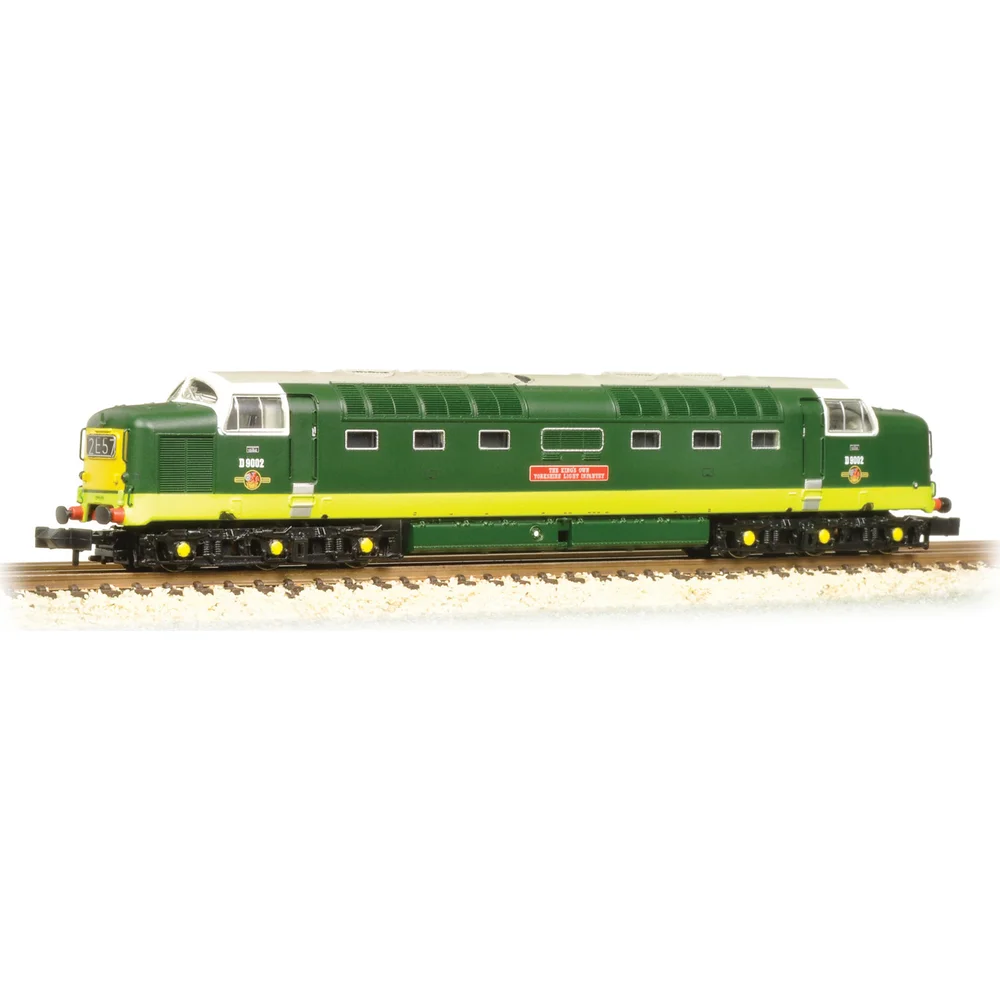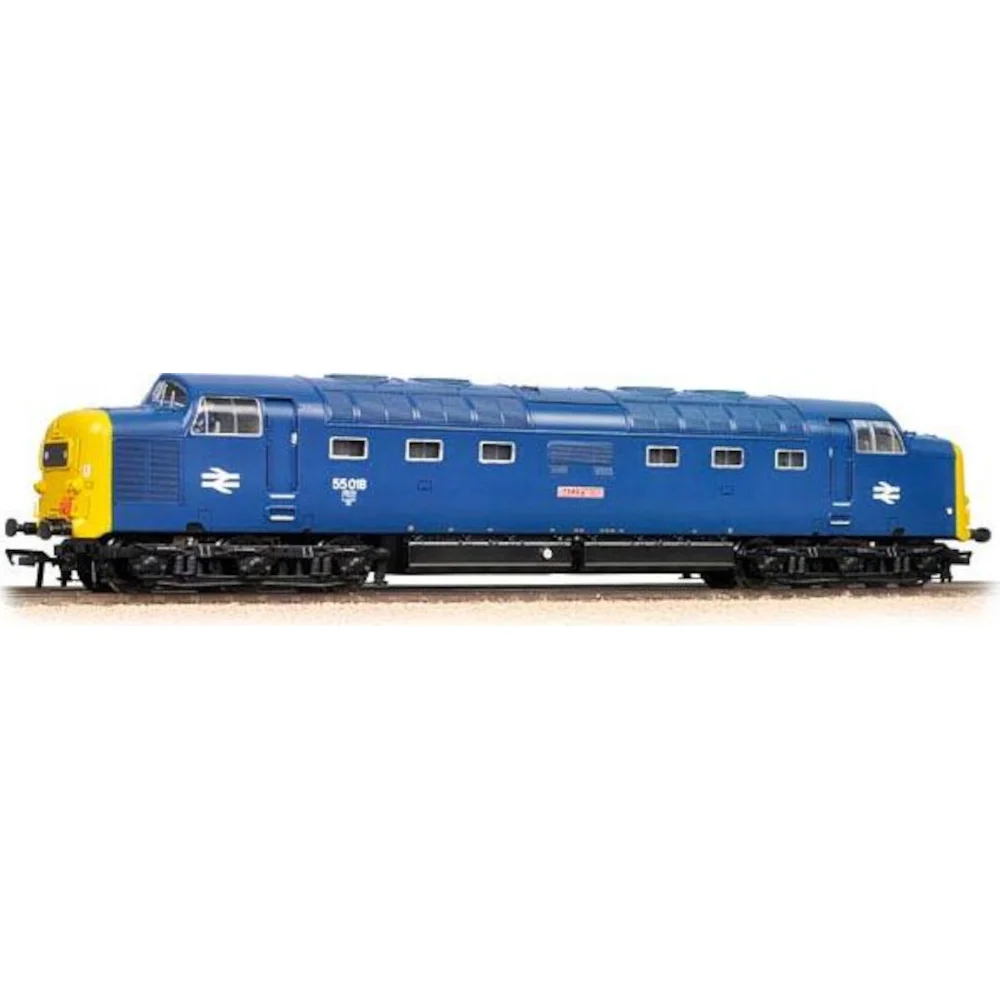British Rail Class 55 – The Deltic Legends of the East Coast Main Line
Contents
The British Rail Class 55 represents the pinnacle of British diesel locomotive engineering during the modernisation era. These magnificent machines, universally known as "Deltics" after their revolutionary Napier engines, transformed the East Coast Main Line between 1961 and 1982. With 3,300 horsepower from twin engines arranged in a unique triangular configuration, they were the world's most powerful single-unit diesel locomotives when introduced. Twenty-two locomotives hauled prestigious services including The Flying Scotsman, cutting London-Edinburgh journey times to under six hours and establishing regular 100mph diesel operations for the first time in Britain.
For model railway enthusiasts, the BR Class 55 offers exceptional appeal across multiple scales. The distinctive streamlined profile, named after British Army regiments, and that unmistakable exhaust roar have made Deltics railway modelling icons. Accurascale's award-winning OO gauge models set new standards for detail and sound quality, whilst Graham Farish dominates N gauge and Heljan offers premium O gauge options. Six preserved examples continue operating on heritage railways and occasional mainline tours, ensuring the Deltic legend endures for future generations.
From engineering innovation through operational excellence to preservation success, the Deltic story encompasses everything that makes British railway history compelling. The revolutionary opposed-piston engines, the regimental names that created emotional connections with the public, the record-breaking performances on demanding gradients, and the six survivors now treasured by preservation societies—all combine to make the Class 55 one of Britain's most celebrated locomotive classes.
Quick Takeaways
- Twenty-two locomotives built: English Electric constructed the entire Class 55 fleet at Vulcan Foundry between 1961-1962, each costing £155,000
- Revolutionary twin-engine design: Paired Napier Deltic 18-cylinder opposed-piston engines in triangular configuration delivered 3,300hp—world-leading power density for 1961
- 21-year East Coast Main Line dominance: From 1961 introduction until 1982 withdrawal, Deltics transformed ECML express services with regular 100mph operations
- Regimental naming tradition: All 22 locomotives carried names of British Army regiments, divided between racehorse names (Finsbury Park), North-East regiments (Gateshead), and Scottish regiments (Haymarket)
- Flying Scotsman transformation: Deltic haulage cut the legendary London-Edinburgh service from seven hours to 5½ hours by 1973, averaging over 71mph
- Six preserved survivors: D9000 Royal Scots Grey, 55002 The King's Own Yorkshire Light Infantry, D9009 Alycidon, D9015 Tulyar, D9016 Gordon Highlander, and D9019 Royal Highland Fusilier survive in museums and preservation societies
- Comprehensive model availability: Accurascale leads OO gauge (£169.99-£270), Graham Farish dominates N gauge (£70-115), Heljan offers O gauge (£595-729), with TT gauge announced for 2026
Historical Background and Context
The genesis of the Deltic locomotive traced back to the Royal Navy's quest for compact, powerful marine engines during World War Two. D. Napier & Son Limited developed the Deltic engine for motor torpedo boats requiring exceptional power-to-weight ratios. Named after the Greek letter Delta (Δ), this revolutionary powerplant featured three cylinder banks arranged in an equilateral triangle with three crankshafts positioned at each apex. The opposed-piston, two-stroke diesel design eliminated cylinder heads and valves entirely, achieving remarkable power density previously impossible with conventional marine diesels.
English Electric recognised the railway potential of this compact, powerful engine and developed prototype locomotive DP1 during the early 1950s. Built at Dick, Kerr Works in Preston, this striking machine in blue and gold livery entered service in March 1955, accumulating 450,000 miles hauling freight between London and Liverpool over six years. The prototype demonstrated that Napier's radical naval engine could successfully power railway traction whilst proving significantly more reliable than the troublesome gas turbines British Railways was simultaneously testing.
British Railways' 1955 Modernisation Plan created urgent demand for powerful diesel locomotives capable of replacing steam on non-electrified main lines. The East Coast Main Line presented particular challenges—393 miles from London King's Cross to Edinburgh with demanding gradients including the notorious climb to Stoke Summit. Existing diesel designs including the English Electric Type 4 (later Class 40) proved inadequate for the high-speed express services BR demanded. With 2,000 horsepower from 133-ton locomotives, the Type 4s simply couldn't match the performance of the LNER A4 Pacifics they were replacing.
Line Traffic Manager Gerry Fiennes championed a revolutionary solution: purpose-built locomotives employing twin Napier Deltic engines to deliver 3,300 horsepower—65% more power than Type 4s from 25% less weight. In March 1958, British Railways ordered 22 production Deltics from English Electric at £155,000 each—equivalent to approximately £4.57 million in today's values. This substantial investment would replace 55 steam locomotives whilst delivering performance that finally matched and exceeded the legendary streamlined Pacifics of the pre-war era.
Insider Tip: The Deltic Naming Tradition
The 22 Deltics received names following depot allocation traditions that created remarkable public engagement. Finsbury Park's fleet carried racehorse names including Royal Scots Grey, Meld, and Crepello—continuing LNER's equine naming tradition. Gateshead locomotives bore North-East regiment names like The Green Howards and The Durham Light Infantry. Haymarket's Scottish-allocated examples celebrated regiments including Gordon Highlander and Royal Highland Fusilier. This regimental naming gave diesels a personality and emotional connection rarely achieved by BR's modernisation programme, cementing the Deltics' iconic status.
Vulcan Foundry at Newton-le-Willows constructed all 22 locomotives between January 1961 and March 1962. Production proceeded swiftly once the complex engineering challenges were resolved. D9000 Royal Scots Grey, the first production locomotive, entered service in March 1961 wearing the distinctive two-tone Brunswick green livery with small yellow warning panels. The remaining 21 locomotives followed at approximately monthly intervals, completing the fleet by spring 1962.
The Deltics immediately established themselves as Britain's flagship diesel locomotives. At 99 tons with 3,300 horsepower, they achieved the world's highest power-to-weight ratio for diesel-electric traction. Route Availability 5 classification meant these powerful machines could operate across the vast majority of BR's network, unlike some contemporary designs restricted by high axle loadings. The combination of exceptional power, moderate weight, and sophisticated engineering created locomotives that would dominate East Coast Main Line express services for two decades.
Design and Technical Specifications
The engineering heart of every BR Class 55 comprised two Napier Deltic D18-25 Series II Type V diesel engines, each delivering 1,650 horsepower at 1,500 RPM. These extraordinary powerplants represented opposed-piston, two-stroke diesel design at its most sophisticated. Each engine featured 18 cylinders arranged in three banks forming an equilateral triangle, with 36 pistons in total—two pistons per cylinder moving towards each other from opposite ends. Three crankshafts positioned at the triangle's corners coordinated piston movement, with two rotating in one direction and the third counter-rotating to achieve correct phasing.
The Deltic engine's compact dimensions—just 11 feet long, six feet wide, and seven feet tall—enabled twin-engine installation within the locomotive's 69-foot 6-inch length whilst maintaining cab space and auxiliary equipment. Each engine weighed only 3,950 kilograms yet produced 1,650 horsepower, achieving power density double that of conventional railway diesels. The uniflow scavenging system, combined with centrifugal blowers providing forced induction, created the distinctive high-pitched exhaust note that made Deltics instantly recognisable. At idle, blue smoke from oil accumulation in exhaust drums created another characteristic Deltic signature.
British Railways adopted revolutionary maintenance philosophy for these complex engines. Rather than repairing failed engines on locomotives, BR kept 13 spare engines at Doncaster Works. When engine failure occurred, the entire powerplant could be exchanged in approximately 24 hours—dramatically reducing out-of-service time compared to conventional locomotives requiring weeks for major repairs. This unit-exchange system maximised fleet availability despite the engines' sophistication, though spare engine provision added significant capital costs to the overall Deltic programme.
Power transmission followed diesel-electric principles with English Electric generators and six nose-suspended DC traction motors driving the Co-Co wheel arrangement. The two main generators, one per engine, operated in parallel to supply the six motors—one per axle. Control systems allowed either engine to power the entire locomotive if necessary, providing redundancy that occasionally proved valuable during service. The electrical transmission delivered smooth, progressive power application particularly suited to high-speed passenger work.
Technical Innovation: The Triangular Engine Configuration
The Napier Deltic's triangular opposed-piston design eliminated components that plagued conventional diesels. With no cylinder heads, no valves, no valve gear, and no camshafts, the design reduced complexity whilst achieving exceptional power density. Two pistons approached each other from opposite cylinder ends, meeting at the combustion zone between them. Ports uncovered by piston movement controlled gas flow—exhaust ports at cylinder centres and inlet ports at the ends. This elegant solution delivered twice the operating speed of conventional engines whilst maintaining reliability that exceeded BR's expectations throughout the class's service life.
The locomotive structure featured a streamlined body designed by English Electric's industrial design team. The distinctive profile with sloping nose ends and bodyside ventilation grilles created an immediately recognisable silhouette. Original two-tone Brunswick green livery with small yellow warning panels gave way from 1967 to full yellow ends for improved visibility. Rail blue started replacing green from 1966, with the final locomotives repainted by the mid-1970s. Some late-era Finsbury Park allocations carried distinctive white cab window surrounds.
Braking systems evolved throughout the Deltics' careers. Original vacuum brakes matched the coaching stock of the early 1960s, but dual vacuum/air braking appeared from 1966-1968 as BR transitioned to air-braked passenger stock. The locomotive's own brake system featured disc brakes on all six axles, providing exceptional stopping power for 100mph operations with 12-coach formations weighing over 400 tons.
| Specification | Value |
|---|---|
| Power output | 3,300 hp (2,460 kW) from twin engines |
| Engine type | 2 × Napier Deltic D18-25 Series II 18-cylinder opposed-piston two-stroke diesels |
| Engine arrangement | Three cylinder banks in triangular configuration, 36 pistons total, 3 crankshafts |
| Power per engine | 1,650 hp (1,230 kW) at 1,500 RPM |
| Maximum speed | 100 mph (161 km/h) |
| Weight | 99 long tons (101 tonnes) |
| Length | 69 ft 6 in (21.18 m) |
| Width | 8 ft 8 in (2.64 m) |
| Height | 12 ft 10 in (3.91 m) |
| Wheel arrangement | Co-Co (all six axles powered) |
| Tractive effort | 52,500 lbf (233.5 kN) at 25% adhesion |
| Route availability | 5 |
| Transmission | Diesel-electric, English Electric generators and 6 DC traction motors |
| Train heating | Steam generators (original); Electric Train Heating from 1970-1971 |
| Builder | English Electric, Vulcan Foundry, Newton-le-Willows |
| Built | 1961-1962 |
| Number built | 22 locomotives (D9000-D9021, later 55001-55022) |
Train heating evolved from steam generators to Electric Train Heating equipment fitted during 1970-1971. This modification improved reliability whilst eliminating water consumption and the maintenance burden of steam-raising equipment. The ETH conversion coincided with BR's introduction of air-conditioned Mark 2 coaching stock requiring electrical rather than steam heating systems.
Service History and Operations
The BR Class 55 fleet transformed East Coast Main Line operations from the moment D9000 Royal Scots Grey entered regular service in March 1961. Initial deployments saw Deltics working traditional steam-era schedules, but their capabilities quickly prompted more ambitious timetabling. The June 1962 service revision, implemented once all 22 locomotives were operational, slashed London-Edinburgh journey times from seven hours to six hours—finally matching and exceeding the pre-war Coronation streamliner's best performances behind LNER A4 Pacifics.
The three allocation depots each developed distinctive operational patterns. Finsbury Park in North London handled the glamour expresses including The Flying Scotsman, The Talisman, and high-speed business services to Leeds and Hull. Gateshead depot near Newcastle covered Scottish and North-Eastern services, with locomotives working intensively across the region. Haymarket at Edinburgh operated Scottish-based diagrams including northbound workings to Aberdeen and Perth. All three depots maintained exceptional availability rates through disciplined maintenance regimes and the unit-exchange engine replacement system.
The Flying Scotsman service represented the Deltics' showcase working. This legendary train, operating continuously since 1862, reached its zenith under Deltic haulage with mid-1970s timings of 5 hours 30 minutes for the 393-mile journey with a single stop at Newcastle. Average speeds exceeded 71mph over challenging gradients including the notorious climb to Stoke Summit. Deltics would attack this 1-in-100 gradient at 90mph with 12-coach trains weighing over 400 tons, barely slowing as they crested the summit—performance that astonished observers accustomed to steam locomotives fighting the climb at 40-50mph.
High-speed running became routine Deltic territory. Crews regularly operated at 90-100mph between stations, with speeds occasionally exceeding 110mph on favourable gradients. The characteristic high-pitched exhaust note from twin Napier engines at full power became synonymous with ECML express travel during the 1960s and 1970s. Passengers experienced smooth, vibration-free acceleration and the distinctive sensation of sustained three-figure speeds—a revelation compared to steam-hauled services.
Operational Insight: The Hull Executive
The Hull Executive, introduced in May 1978, became Britain's fastest regular locomotive-hauled passenger train. Northbound timings from King's Cross to Retford required 91.4mph averages, demanding sustained 100-110mph running on the level sections. Deltics made this punishing schedule appear effortless, accelerating rapidly from station stops and maintaining triple-figure speeds for miles. The service demonstrated that even as High Speed Trains arrived to replace them, Deltics remained capable of extraordinary performance that few other diesel locomotives could match.
The ultimate Deltic performance came in February 1978 when a driver arranged a spectacular farewell run. Taking 55008 The Green Howards from Newcastle to King's Cross with ten coaches, the locomotive achieved a net time of 115 minutes 45 seconds—a 97mph average start-to-stop over 268 miles. Speeds reached 113mph near Darlington, 114mph at Offord, and an astonishing 125mph descending Stoke Bank. This performance demonstrated that with modern infrastructure, Deltics could realistically achieve King's Cross to Edinburgh in under five hours.
Beyond glamour expresses, Deltics handled diverse duties including parcels trains, newspaper services, and occasional freight workings when passenger diagrams permitted. Sleeper services including The Aberdonian benefited from Deltic reliability and smooth running that passengers appreciated during overnight journeys. Semi-fast services and relief trains filled diagrams between premier workings, ensuring the fleet accumulated impressive mileages—typically 500 miles daily per locomotive.
Technical improvements throughout the service period maintained competitiveness. Electric Train Heating installation from 1970-1971 enabled operation with air-conditioned Mark 2 coaching stock. Air brake equipment fitted from 1966-1968 matched evolving rolling stock standards. Modifications to lighting, cab equipment, and auxiliary systems kept Deltics current with evolving operational requirements despite their fundamentally 1950s-vintage design.
The introduction of High Speed Trains from 1978 marked the beginning of the end for Deltics. These new 125mph InterCity 125 sets offered superior performance, lower operating costs, and standardisation benefits. By May 1979, all surviving Deltics had concentrated at York depot for their final years, increasingly relegated to semi-fast services, sleepers, and newspaper trains as HSTs took over top-link express diagrams.
Final withdrawals proceeded swiftly once the decision was made. Three locomotives were withdrawn in 1980, sixteen followed during 1981, and the final trio operated until 2nd January 1982. The last revenue service fell to 55019 Royal Highland Fusilier working the 16:30 Aberdeen-York service on 31st December 1981. The next day, enthusiast special "Deltic Scotsman Farewell" saw 55015 Tulyar and 55022 Royal Scots Grey work from King's Cross to Edinburgh and return, shadowed by 55009 Alycidon. All three were withdrawn upon arrival at York, ending 21 years of Deltic operations.
Fleet
No locomotives found.
Withdrawal and Preservation Legacy
The withdrawal of the BR Class 55 fleet between 1980 and 1982 reflected economic reality rather than mechanical inadequacy. High Speed Train introduction provided 125mph capability, standardisation benefits, and lower per-mile operating costs that a small fleet of complex, non-standard locomotives couldn't match. The Deltics remained mechanically capable—indeed, preservation operations over subsequent decades would demonstrate their fundamental soundness—but BR's policy against maintaining small fleets sealed their fate.
Early withdrawals began in 1980 when three locomotives succumbed after component failures made repairs uneconomical. The pace accelerated during 1981 as HST deliveries enabled systematic Deltic displacement from premier services. By the end of 1981, only three remained operational: 55009 Alycidon, 55015 Tulyar, and 55022 Royal Scots Grey. These final survivors operated until January 1982, with 55019 Royal Highland Fusilier working the last revenue service on New Year's Eve 1981.
The preservation movement recognised Deltic significance immediately. The small fleet size—just 22 locomotives versus hundreds of other diesel classes—created urgency around securing survivors before all were scrapped. The locomotives' iconic status, exceptional performance, and the passionate following they'd developed during service life ensured preservation efforts gained momentum quickly. Remarkably, six Deltics survived—a 27% survival rate exceptional for any locomotive class.
D9000/55022 Royal Scots Grey became the preservation movement's first Deltic acquisition. The Deltic 9000 Fund, formed in 1981, purchased this iconic locomotive and eventually achieved mainline certification for railtour operation. Based at Crewe under Locomotive Services Limited ownership, Royal Scots Grey worked regular mainline tours during the 1990s and 2000s. Currently out of service awaiting repairs, it remains one of three mainline-certified Deltics and occasionally visits heritage railways including a November 2025 appearance at North Norfolk Railway.
D9002/55002 The King's Own Yorkshire Light Infantry entered the National Railway Museum collection, where it remains on public display in the North Shed at York. Mainline certified for movements between NRM sites, it primarily serves as a static exhibit representing the class in the National Collection. The museum's free admission enables thousands of visitors annually to appreciate Deltic design and learn about their East Coast Main Line service.
Preservation's Triumph: The Deltic Preservation Society
The Deltic Preservation Society, formed in 1977 whilst the class still operated in service, has become the guardian of three preserved Deltics. Based at Barrow Hill Roundhouse in Derbyshire, the DPS maintains D9009 Alycidon, D9015 Tulyar, and D9019 Royal Highland Fusilier. The society's dedication includes the remarkable 28-year restoration of Tulyar, which achieved the milestone of both engines running in April 2025 for the first time since 1997. DPS Deltics regularly appear at heritage railway diesel galas and occasionally work mainline railtours, ensuring new generations experience these magnificent machines in operation.
D9009/55009 Alycidon, owned by the Deltic Preservation Society, currently holds mainline certification and has worked railtours as recently as July 2023. Based at Barrow Hill Roundhouse, Alycidon represents the most actively used mainline Deltic, though recent reliability challenges have emerged requiring attention. Heritage railway appearances at diesel galas remain regular, with enthusiasts appreciating opportunities to see and hear this iconic locomotive in operation.
D9015/55015 Tulyar has been under restoration since 1997, representing one of preservation's most ambitious long-term projects. April 2025 brought the milestone of both Napier engines running simultaneously for the first time in 28 years. Final testing is underway before transfer to the Great Central Railway for extensive running-in prior to mainline certification. The DPS's determination to return this locomotive to operation demonstrates the depth of commitment preservation societies bring to maintaining these complex machines.
D9016/55016 Gordon Highlander is cosmetically restored in original two-tone Brunswick green livery and displayed at The One:One Collection museum in Margate. One engine was donated to sister locomotive 55022 Royal Scots Grey, meaning Gordon Highlander serves primarily as a static exhibit showcasing the Deltic's elegant original appearance. The museum setting enables public appreciation of Deltic design and engineering without the operational demands of active preservation.
D9019/55019 Royal Highland Fusilier operates as the Deltic Preservation Society's most reliable locomotive. Regular appearances at heritage railways including the Great Central Railway and numerous diesel galas enable enthusiasts nationwide to experience Deltic operations. Though not currently mainline certified, plans exist for future certification once equipment upgrades to modern standards are completed. Royal Highland Fusilier's operational status makes it the most accessible preserved Deltic for enthusiasts seeking the authentic sight and sound of these remarkable machines.
Preservation society operations demonstrate the Deltics' fundamental engineering soundness. Despite complexity and 1950s-vintage design, preserved examples achieve reliability levels that enable regular heritage railway service and occasional mainline railtours. The unit-exchange engine philosophy continues in preservation, with societies maintaining spare powerplants to minimise out-of-service time. Modern lubricants and careful maintenance practices have actually improved reliability compared to BR service, when intensive daily diagrams and minimal maintenance windows created different operational pressures.
Modelling Significance and Scale Replications
The BR Class 55 presents exceptional modelling significance due to its iconic status, distinctive appearance, and the passionate following Deltics maintain among railway enthusiasts. Model manufacturers across multiple scales have recognised this appeal, creating representations ranging from budget-friendly starter locomotives to premium models with sophisticated DCC sound systems capturing the authentic Napier engine roar. The variety of available models enables enthusiasts to recreate East Coast Main Line operations from the 1960s modernisation era through the early 1980s transition to High Speed Trains.
The current benchmark in OO gauge comes from Accurascale, whose Class 55 range won "OO Locomotive of the Year" from Hornby Magazine following release in 2022. These premium models represent the manufacturer's first locomotive project and established Accurascale as a serious force in British outline railway modelling. Two production batches covered all 22 original Deltics across multiple liveries and era-specific detail variations.
Accurascale models feature die-cast chassis weighing approximately 900 grams, providing exceptional traction for hauling long passenger formations typical of Deltic operations. The magnetic body cover enables easy removal for decoder access without disturbing delicate handrails or other separately-applied details. DCC Ready versions (catalogue numbers 2320-001 through 2320-022) carry a recommended retail price of £169.99 and include a 21-pin decoder socket plus stay-alive circuitry for reliable running over dirty track or insulated crossings.
DCC Sound Fitted models (RRP £250-270) incorporate twin-speaker ESU LokSound V5.0 systems with authentic Napier Deltic engine recordings. The sound quality proves exceptional, capturing the characteristic high-pitched growl at speed, the distinctive exhaust note under power, brake squeal, horns, and numerous other prototypical effects. The twin-speaker installation delivers superior audio performance compared to single-speaker systems, with separate bass and treble speakers providing fuller sound reproduction across the frequency range.
Era-specific details distinguish Accurascale's approach. Early-era models feature cast bogies, small yellow warning panels, and original equipment positioning. Later variants show fabricated bogies, full yellow ends from 1967 onwards, Electric Train Heating equipment on post-1971 examples, and air brake modifications. The attention to these variations enables modellers to select locomotives accurately representing their chosen period rather than settling for generic compromises.
Bachmann Branchline produced Class 55 models from 2003 through approximately 2008, occupying the market before Accurascale's arrival. Many catalogue numbers are now sold out, but models occasionally appear on the secondary market. The 32-529 series covered various liveries with later production featuring 21-pin DCC sockets and five-pole motors. Whilst Accurascale's superior detail and sound systems have superseded them, Bachmann Deltics remain solid performers suitable for operators who missed more recent releases.
Hornby's Railroad Plus range offers budget-conscious alternatives using older Lima tooling with updated mechanisms. Models like R30438 (55002 The King's Own Yorkshire Light Infantry in BR green, £67-75) or sound-fitted versions (R30438TXS, £116-130) provide acceptable representations at entry-level prices. Detail levels can't match Accurascale, but these models run reliably and suit operators prioritising value over ultimate accuracy. The 8-pin DCC socket enables straightforward decoder installation for digital control enthusiasts.
Advanced Modelling: Capturing Authentic Deltic Sound
The Deltic's distinctive exhaust note represents British dieseldom's most recognisable sound signature. The twin Napier engines' high-pitched roar—earning the nickname "Tractors" among crews—proved instantly identifiable to railway enthusiasts. Modern DCC sound decoders capture this sonic character remarkably well, with ESU LokSound V5.0 systems offering authentic recordings from preserved locomotives. For ultimate authenticity, operators should programme decoder CVs to replicate prototypical acceleration and braking characteristics—Deltics accelerated rapidly but smoothly, whilst their powerful disc brakes on all six axles enabled confident high-speed stops.
In N gauge, Graham Farish dominates with an extensive range introduced from 2003 and updated in 2014. Models like 371-275 (D9000 Royal Scots Grey in two-tone green, £70-90) deliver impressive detail levels for 2mm scale. The 6-pin DCC socket, directional lighting, and accessory packs containing bufferbeam details enable customisation to match specific prototypes. The prototypical Co-Co drive with all wheels powered and picking up current provides excellent haulage capacity for long N gauge passenger formations typical of Deltic operations.
Graham Farish catalogue numbers span the full Deltic era from original two-tone green through Rail Blue to final BR blue with white cab window surrounds. Era-specific variations include Electric Train Heating connections on post-1971 models and bonnet-mounted twin horns on blue livery examples. Prices range from £70-115 depending on specific catalogue number and availability, with sound-fitted versions commanding approximately £130-160.
O gauge modellers benefit from Heljan's completely redesigned Class 55 tooling released in 2023. These substantial models carry a recommended retail price of £729, though discounts to approximately £595 are common through specialist retailers. Twin five-pole motors with twin flywheels drive all twelve wheels through geared transmission to both bogies, providing exceptional haulage capacity and smooth slow-speed control suitable for exhibition-quality operations.
Heljan's O gauge Deltics feature cast and fabricated bogie options matching prototype variations, detailed engine room interiors visible through bodyside grilles, and provision for twin speakers plus twin smoke units for ultimate realism. The ESU XL interface enables plug-and-play DCC installation without soldering, whilst all-wheel electrical pickup ensures reliable current collection. Catalogue numbers like 5530 (D9000 in BR two-tone green) and 5531 (55019 in BR blue with full yellow ends) capture different eras authentically.
Interestingly, Heljan announced TT gauge (1:120 scale) Class 55 models for 2026 delivery at £189.99 recommended retail price. Ten different liveries spanning the Deltic era will be available, potentially establishing Deltics as flagship models for this increasingly popular scale. The announcement demonstrates continued manufacturer confidence in Deltic commercial appeal across multiple scales and markets.
DCC sound represents the ultimate enhancement for Deltic models across all scales. Factory-fitted options from Accurascale deliver exceptional quality with authentic Napier engine recordings, prototypical horns, brake sounds, and that distinctive high-pitched growl under power. Aftermarket decoders like ESU LokSound V5.0 Class 55 variants (approximately £109.50 in 21-pin or 8-pin formats) enable operators to upgrade non-sound models with authentic audio. The Deltic sound signature—arguably British dieseldom's most distinctive—transforms layouts through instantly recognisable audio that adds tremendous operational atmosphere.
Models
| Builder | Catalogue # | Year | Running # | Class, Operator (Livery) "Name" | Scale | Finish | Era | DCC |
|---|---|---|---|---|---|---|---|---|
| Accurascale | ACC2150D9000 | 55022 | British Rail Class 55, British Rail (Blue) "Royal Scots Grey" | OO | P | 7 | DCC21 | |
| Accurascale | ACC2150D9000DCC | 55022 | British Rail Class 55, British Rail (Blue) "Royal Scots Grey" | OO | P | 7 | DCCS | |
| Accurascale | ACC2151D9001 | 55001 | British Rail Class 55, British Rail (Blue) "St. Paddy" | OO | P | 7 | DCC21 | |
| Accurascale | ACC2151D9001DCC | 55001 | British Rail Class 55, British Rail (Blue) "St. Paddy" | OO | P | 7 | DCCS | |
| Accurascale | ACC2153D9003 | 55003 | British Rail Class 55, British Rail (Blue) "Meld" | OO | P | 7 | DCC21 | |
| Accurascale | ACC2153D9003DCC | 55003 | British Rail Class 55, British Rail (Blue) "Meld" | OO | P | 7 | DCCS | |
| Accurascale | ACC2154D9004 | D9004 | British Rail Class 55, British Railways (Two-Tone Green) | OO | P | 5 | DCC21 | |
| Accurascale | ACC2154D9004DCC | D9004 | British Rail Class 55, British Railways (Two-Tone Green) | OO | P | 5 | DCCS | |
| Accurascale | ACC2155D9005 | 55005 | British Rail Class 55, British Rail (Blue) "The Prince of Wales' Own Regiment of Yorkshire" | OO | P | 7 | DCC21 | |
| Accurascale | ACC2155D9005DCC | 55005 | British Rail Class 55, British Rail (Blue) "The Prince of Wales' Own Regiment of Yorkshire" | OO | P | 7 | DCCS | |
| Accurascale | ACC2156D9006 | D9006 | British Rail Class 55, British Railways (Two-Tone Green) "The Fife and Forfar Yeomanry" | OO | P | 5 | DCC21 | |
| Accurascale | ACC2156D9006DCC | D9006 | British Rail Class 55, British Railways (Two-Tone Green) "The Fife and Forfar Yeomanry" | OO | P | 5 | DCCS | |
| Accurascale | ACC2157D9007 | D9007 | British Rail Class 55, British Railways (Green with Late Crest) "Pinza" | OO | P | 5 | DCC21 | |
| Accurascale | ACC2157D9007DCC | D9007 | British Rail Class 55, British Railways (Green with Late Crest) "Pinza" | OO | P | 5 | DCCS | |
| Accurascale | ACC2160D9010 | D9010 | British Rail Class 55, British Rail (Green) "The King's Own Scottish Borderer" | OO | P | 6 | DCC21 | |
| Accurascale | ACC2160D9010DCC | D9010 | British Rail Class 55, British Rail (Green) "The King's Own Scottish Borderer" | OO | P | 6 | DCCS | |
| Accurascale | ACC2161D9011 | 55011 | British Rail Class 55, British Rail (Blue) "The Royal Northumberland Fusiliers" | OO | P | 7 | DCC21 | |
| Accurascale | ACC2161D9011DCC | 55011 | British Rail Class 55, British Rail (Blue) "The Royal Northumberland Fusiliers" | OO | P | 7 | DCCS | |
| Accurascale | ACC2162D9012 | D9012 | British Rail Class 55, British Rail (Blue) "Crepello" | OO | P | 7 | DCC21 | |
| Accurascale | ACC2162D9012DCC | D9012 | British Rail Class 55, British Rail (Blue) "Crepello" | OO | P | 7 | DCCS | |
| Accurascale | ACC2163D9013 | D9013 | British Rail Class 55, British Railways (Two-Tone Green) "The Black Watch" | OO | P | 5 | DCC21 | |
| Accurascale | ACC2163D9013DCC | D9013 | British Rail Class 55, British Railways (Two-Tone Green) "The Black Watch" | OO | P | 5 | DCCS | |
| Accurascale | ACC2164D9014 | D9014 | British Rail Class 55, British Railways (Two-Tone Green) "The Duke of Wellington's Regiment" | OO | P | 5 | DCC21 | |
| Accurascale | ACC2164D9014DCC | D9014 | British Rail Class 55, British Railways (Two-Tone Green) "The Duke of Wellington's Regiment" | OO | P | 5 | DCCS | |
| Accurascale | ACC2166D9016 | 9016 | British Rail Class 55, Porterbrook Leasing Company Limited (Silver & Purple) "Gordon Highlander" | OO | P | 9 | DCC21 | |
| Accurascale | ACC2166D9016DCC | 9016 | British Rail Class 55, Porterbrook Leasing Company Limited (Silver & Purple) "Gordon Highlander" | OO | P | 9 | DCCS | |
| Accurascale | ACC2167D9017 | 55017 | British Rail Class 55, British Rail (Blue) "The Durham Light Infantry" | OO | P | 7 | DCC21 | |
| Accurascale | ACC2167D9017DCC | 55017 | British Rail Class 55, British Rail (Blue) "The Durham Light Infantry" | OO | P | 7 | DCCS | |
| Accurascale | ACC2168D9018 | 55018 | British Rail Class 55, British Rail (Blue) "Ballymoss" | OO | P | 7 | DCC21 | |
| Accurascale | ACC2168D9018DCC | 55018 | British Rail Class 55, British Rail (Blue) "Ballymoss" | OO | P | 7 | DCCS | |
| Accurascale | ACC2170D9020 | D9020 | British Rail Class 55, British Railways (Green with Late Crest) "Nimbus" | OO | P | 5 | DCC21 | |
| Accurascale | ACC2170D9020DCC | D9020 | British Rail Class 55, British Railways (Green with Late Crest) "Nimbus" | OO | P | 5 | DCCS | |
| Accurascale | ACC2171D9021 | 9021 | British Rail Class 55, British Rail (Blue) "Argyll and Sutherland Highlander" | OO | P | 6 | DCC21 | |
| Accurascale | ACC2171D9021DCC | 9021 | British Rail Class 55, British Rail (Blue) "Argyll and Sutherland Highlander" | OO | P | 6 | DCCS | |
| Bachmann | 32-525 | 2002 | D9004 | British Rail Class 55, British Railways (Green with Late Crest) "Queens Own Highlander" | OO | P | 5 | DCC8 |
| Bachmann | 32-525A† | D9002 | British Rail Class 55, British Railways (Two-Tone Green) | OO | P | 5 | DCC8 | |
| Bachmann | 32-525A | 2004 | 55002 | British Rail Class 55, British Railways (Green with Late Crest) "The Kings Own Yorkshire Light Infantry" | OO | P | 5 | DCC8 |
| Bachmann | 32-525DS | 2006 | D9007 | British Rail Class 55, British Railways (Two-Tone Green) "Pinza" | OO | P | 5 | DCCS |
| Bachmann | 32-525Q* | D9008 | British Rail Class 55, British Railways (Two-Tone Green) "The Green Howards" | OO | P | 5 | DCC8 | |
| Bachmann | 32-525R* | 55008 | British Rail Class 55, British Rail (Blue) "The Green Howards" | OO | P | 7 | DCC8 | |
| Bachmann | 32-525S* | 55008 | British Rail Class 55, British Rail (Blue) "The Green Howards" | OO | W | 7 | DCC8 | |
| Bachmann | 32-525T* | 55022 | British Rail Class 55, British Rail (Blue) "Royal Scots Grey" | OO | P | 7 | DCC8 | |
| Bachmann | 32-525U* | D9003 | British Rail Class 55, British Railways (Two-Tone Green) | OO | P | 5 | DCC8 | |
| Bachmann | 32-525UA* | D9003 | British Rail Class 55, British Railways (Two-Tone Green) "Meld" | OO | W | 5 | DCC8 | |
| Bachmann | 32-525UB* | D9003 | British Rail Class 55, British Railways (Two-Tone Green) "Meld" | OO | P | 5 | DCC8 | |
| Bachmann | 32-525V* | 55015 | British Rail Class 55, British Rail (Blue) "Tulyar" | OO | P | 7 | DCC8 | |
| Bachmann | 32-525W* | 55019 | British Rail Class 55, British Rail (Blue) "Royal Highland Fusilier" | OO | W | 7 | DCC8 | |
| Bachmann | 32-525X* | D9021 | British Rail Class 55, British Railways (Two-Tone Green) "Argyll & Sutherland" | OO | P | 5 | DCC8 | |
| Bachmann | 32-525Y* | D9021 | British Rail Class 55, British Railways (Two-Tone Green) "Argyll & Sutherland" | OO | W | 5 | DCC8 | |
| Bachmann | 32-525Z* | 55009 | British Rail Class 55, British Rail (Blue) "Alycidon" | OO | P | 7 | DCC8 | |
| Bachmann | 32-526 | 2002 | 55020 | British Rail Class 55, British Rail (Blue) "Nimbus" | OO | P | 7 | DCC8 |
| Bachmann | 32-526DS | 2011 | 55018 | British Rail Class 55, British Rail (Blue) "Ballymoss" | OO | P | 7 | DCCS |
| Bachmann | 32-527 | 2004 | 55012 | British Rail Class 55, British Rail (Blue) "Crepello" | OO | P | 7 | DCC8 |
| Bachmann | 32-528 | 2005 | 55013 | British Rail Class 55, British Rail (Blue) "The Black Watch" | OO | P | 7 | DCC8 |
| Bachmann | 32-529 | 2009 | D9017 | British Rail Class 55, British Railways (Two-Tone Green) "The Durham Light Infantry" | OO | P | 5 | DCC21 |
| Bachmann | 32-529† | 2008 | D9019 | British Rail Class 55, British Railways (Two-Tone Green) "Royal Highland Fusiliers" | OO | P | 5 | DCC21 |
| Bachmann | 32-529A | 2011 | D9014 | British Rail Class 55, British Railways (Two-Tone Green) "The Duke of Wellington's Regiment" | OO | P | 5 | DCC21 |
| Bachmann | 32-529B | 2012 | D9011 | British Rail Class 55, British Railways (Two-Tone Green) | OO | W | 5 | DCC21 |
| Bachmann | 32-529C | 2019 | D9010 | British Rail Class 55, British Railways (Two-Tone Green) "The King's Own Scottish Borderer" | OO | P | 5 | DCC21 |
| Bachmann | 32-529CSF | 2019 | D9010 | British Rail Class 55, British Railways (Two-Tone Green) "The King's Own Scottish Borderer" | OO | P | 5 | DCCS |
| Bachmann | 32-530* | D9006 | British Rail Class 55, British Railways (Two-Tone Green) | OO | P | 5 | DCC21 | |
| Bachmann | 32-530 | 55001 | British Rail Class 55, British Rail (Blue) "St. Paddy" | OO | P | 7 | DCC21 | |
| Bachmann | 32-530DS | 2008 | 55001 | British Rail Class 55, British Rail (Blue) "St. Paddy" | OO | P | 7 | DCCS |
| Bachmann | 32-530ZDS* | 55011 | British Rail Class 55, British Rail (Blue) | OO | P | 7 | DCC8 | |
| Bachmann | 32-531DC | 2011 | 9005 | British Rail Class 55, British Rail (Blue) "The Prince of Wale's Own Regiment of Yorkshire" | OO | P | 6/7 | DCCF |
| Bachmann | 32-532 | 2015 | 55007 | British Rail Class 55, British Rail (Blue) "PINZA" | OO | W | 7 | DCC21 |
| Bachmann | 32-532A | 2019 | 55003 | British Rail Class 55, British Rail (Blue) "Meld" | OO | P | 7 | DCC21 |
| Bachmann | 32-532ASF | 2019 | 55003 | British Rail Class 55, British Rail (Blue) "Meld" | OO | P | 7 | DCCS |
| Bachmann | 32-533 | 2015 | D9001 | British Rail Class 55, British Railways (Two-Tone Green) "St. Paddy" | OO | W | 6 | DCC21 |
| Bachmann | 32-534DS | 2016 | 55004 | British Rail Class 55, British Rail (Blue) "Queen's Own Highlander" | OO | P | 7 | DCCS |
| Graham Farish | 371-275 | D9000 | British Rail Class 55, British Railways (Two-Tone Green) "Royal Scots Grey" | N | P | 5 | No | |
| Graham Farish | 371-276 | 2005 | 55006 | British Rail Class 55, British Rail (Blue) "Fife & Forfar Yeomanry" | N | P | 7 | No |
| Graham Farish | 371-277 | 2005 | 55002 | British Rail Class 55, British Railways (Two-Tone Green) "The Kings Own Yorkshire Light Infantry" | N | P | 5 | No |
| Graham Farish | 371-278 | 2009 | 55008 | British Rail Class 55, British Rail (Blue) "The Green Howards" | N | P | 7 | No |
| Graham Farish | 371-285 | 2012 | D9007 | British Rail Class 55, British Railways (Two-Tone Green) "Pinza" | N | P | 5 | DCC6 |
| Graham Farish | 371-285A | 2018 | D9009 | British Rail Class 55, British Railways (Two-Tone Green) "Alycidon" | N | P | 5 | DCC6 |
| Graham Farish | 371-286 | 2012 | D9002 | British Rail Class 55, British Railways (Two-Tone Green) "The Kings Own Yorkshire Light Infantry" | N | P | 5 | DCC6 |
| Graham Farish | 371-287 | 2012 | 55005 | British Rail Class 55, British Rail (Blue) "The Prince of Wales's Own Regiment of Yorkshire" | N | P | 7 | DCC6 |
| Graham Farish | 371-288 | 2018 | 55015 | British Rail Class 55, British Rail (Blue) "Tulyar" | N | P | 7 | DCC6 |
| Graham Farish | 371-289 | 2019 | D9001 | British Rail Class 55, British Railways (Two-Tone Green) "St. Paddy" | N | W | 6 | DCC6 |
| Heljan | 5500 | British Rail Class 55, British Railways (Green with Late Crest) | O | P | 5 | DCCW | ||
| Heljan | 5501 | British Rail Class 55, British Rail (Blue) | O | P | 6/7 | DCCW | ||
| Heljan | 5503 | British Rail Class 55, British Railways (Green with Late Crest) | O | P | 5 | DCCW | ||
| Heljan | 5504 | D9001 | British Rail Class 55, British Railways (Green with Late Crest) "St Paddy" | O | W | 5 | DCCW | |
| Heljan | 5505 | British Rail Class 55, British Railways (Green with Late Crest) | O | P | 5 | DCCW | ||
| Heljan | 5506 | British Rail Class 55, British Rail (Blue) | O | P | 6/7 | DCCW | ||
| Hornby | R1092 | 2007 | D9014 | British Rail Class 55, British Railways (Two-Tone Green) | OO | P | 5 | DCC8 |
| Hornby | R2879 | 2009 | 55001 | British Rail Class 55, British Rail (Blue) "St. Paddy" | OO | P | 7 | DCC8 |
| Hornby | R30048TTS | 2021 | D9018 | British Rail Class 55, British Railways (Two-Tone Green) "Ballymoss" | OO | P | 6 | DCCTTS |
| Hornby | R30048TXS | 2023 | D9018 | British Rail Class 55, British Railways (Two-Tone Green) "Ballymoss" | OO | P | 5 | DCCTXS |
| Hornby | R30049TTS | 2021 | 55013 | British Rail Class 55, British Rail (Blue) "The Black Watch" | OO | P | 7 | DCCTTS |
| Hornby | R30049TXS | 2023 | 55013 | British Rail Class 55, British Rail (Blue) "The Black Watch" | OO | P | 7 | DCCTXS |
| Hornby | R30438 | 2025 | 55002 | British Rail Class 55, British Railways (Two-Tone Green) "The Kings own Yorkshire Light Infantry" | OO | P | 6 | DCC8 |
| Hornby | R30438TXS | 2025 | 55002 | British Rail Class 55, British Railways (Two-Tone Green) "The Kings own Yorkshire Light Infantry" | OO | P | 6 | DCCTXS |
| Hornby | R3497 | 2016 | D9016 | British Rail Class 55, British Railways (Two-Tone Green) | OO | P | 5 | DCC8 |
| Hornby | R3590 | 2017 | 9010 | British Rail Class 55, British Rail (Blue) "The King's Own Scottish Borderer" | OO | P | 5 | DCC8 |
| Lima | L201645 | 9006 | British Rail Class 55, British Rail (Blue) "Fife and Forfar Yeomanry" | OO | P | 6 | No | |
| Lima | L204607 | D9016 | British Rail Class 55, British Railways (Two-Tone Green) "Gordon Highlander" | OO | P | 5 | No | |
| Lima | L204651 | D9000 | British Rail Class 55, British Railways (Two-Tone Green) "Royal Scots Greys" | OO | P | 5 | No | |
| Lima | L204656 | D9015 | British Rail Class 55, British Railways (Two-Tone Green) "Tulyar" | OO | P | 5 | No | |
| Lima | L204657 | D9009 | British Rail Class 55, British Railways (Two-Tone Green) "Alycidon" | OO | P | 5 | No | |
| Lima | L204702 | 55021 | British Rail Class 55, British Rail (Blue) "Argyll and Sutherland Highlander" | OO | P | 7 | No | |
| Lima | L204738 | 55015 | British Rail Class 55, British Rail (Blue) "Tulyar" | OO | P | 7 | No | |
| Lima | L204743 | D9019 | British Rail Class 55, British Railways (Two-Tone Green) "Royal Highland Fusilier" | OO | P | 5 | No | |
| Lima | L204781 | D9001 | British Rail Class 55, British Railways (Two-Tone Green) "St Paddy" | OO | P | 5 | No | |
| Lima | L204801 | 55007 | British Rail Class 55, British Rail (Blue) "Pinza" | OO | P | 7 | No | |
| Lima | L204802 | 55002 | British Rail Class 55, British Railways (Two-Tone Green) "Kings Own Yorkshire Light Infantry" | OO | P | 5 | No | |
| Lima | L204816 | D9013 | British Rail Class 55, British Railways (Two-Tone Green) "The Black Watch" | OO | P | 5 | No | |
| Lima | L204869 | 55009 | British Rail Class 55, British Rail (Blue) "Alycidon" | OO | P | 7 | No | |
| Lima | L204936 | 55010 | British Rail Class 55, British Rail (Blue) "Kings Own Scottish Borderer" | OO | P | 7 | No | |
| Lima | L204951 | D9005 | British Rail Class 55, British Railways (Two-Tone Green) "The Prince of Wales's own Regiment of Yorkshire" | OO | P | 5 | No | |
| Lima | L204952 | D9012 | British Rail Class 55, British Railways (Two-Tone Green) "Crepello" | OO | P | 5 | No | |
| Lima | L204953 | D9020 | British Rail Class 55, British Railways (Two-Tone Green) "Nimbus" | OO | P | 5 | No | |
| Lima | L205105 | D9003 | British Rail Class 55, British Railways (Two-Tone Green) "Meld" | OO | P | 5 | No | |
| Lima | L205105 | D9008 | British Rail Class 55, British Railways (Two-Tone Green) "The Green Howards" | OO | P | 5 | No | |
| Lima | L205106 | 9006 | British Rail Class 55, British Rail (Blue) "Fife and Forfar Yeomanry" | OO | P | 6 | No | |
| Lima | L205106 | 55022 | British Rail Class 55, British Rail (Blue) "Royal Scots Grey" | OO | P | 7 | No | |
| Lima | L205191 | 55017 | British Rail Class 55, British Rail (Blue) "The Durham Light Infantry" | OO | P | 7 | No | |
| Lima | L205222 | D9002 | British Rail Class 55, British Railways (Two-Tone Green) "Kings Own Yorkshire Light Infantry" | OO | P | 5 | No | |
| Lima | L205230 | 55019 | British Rail Class 55, British Rail (Blue) "Royal Highland Fusillier" | OO | P | 7 | No | |
| Lima | L205260 | 9016 | British Rail Class 55, Porterbrook Leasing Company Limited (Silver & Purple) "Gordon Highlander" | OO | P | 9 | No | |
| Lima | L205269 | D9018 | British Rail Class 55, British Railways (Two-Tone Green) "Ballymoss" | OO | P | 5 | No | |
| Lima | L205299 | 55001 | British Rail Class 55, British Rail (Blue) "St.Paddy" | OO | P | 7 | No | |
| Lima | L220253 | D9003 | British Rail Class 55, British Railways (Two-Tone Green) | OO | P | 5 | No |
Unique Modelling Tips and Layout Integration
Successfully incorporating BR Class 55 models into layout operations requires understanding the specialised nature of their prototype duties and the authentic operating scenarios that characterised East Coast Main Line express services between 1961 and 1982. Unlike mixed-traffic diesels suitable for diverse workings, Deltics were purpose-built express passenger locomotives that rarely strayed from their primary role hauling prestigious named trains and high-speed business services.
Authentic operating scenarios should reflect the intensive express passenger role. A typical Deltic duty involved working a prestigious service from London King's Cross to Edinburgh, York, Leeds, or Hull with 10-12 coach formations weighing 400+ tons. The return working would follow several hours later, with intermediate depot servicing if required. Daily diagrams frequently exceeded 500 miles, demanding locomotives that could sustain 90-100mph running for extended periods whilst maintaining schedule adherence despite inevitable delays and signal checks.
Layout design should accommodate the Deltics' operational characteristics and typical infrastructure. The East Coast Main Line featured long, relatively straight sections enabling sustained high-speed running—modellers can represent this through generous curve radii (minimum third radius for OO, equivalent standards for other scales) and extended straight sections. The characteristic ECML infrastructure including multiple-aspect colour-light signals, electrification masts (from the 1980s onwards in the London area), and substantial station platforms reflects the premier route status.
Weathering Authenticity for Premier Express Service
Deltic weathering should reflect their prestigious express passenger role rather than heavy mixed-traffic work. These locomotives received regular cleaning, especially when allocated to flagship services like The Flying Scotsman. Light weathering around bogies, buffer beams, and roof areas proves most authentic—focus on rail dust along solebar edges, brake dust around wheelsets, and exhaust residue around the distinctive roof-mounted radiator grilles. The characteristic blue exhaust staining from the Napier engines adds character without excessive effects. Heavily weathered Deltics suit late-era scenarios (1978-1982) when maintenance standards declined as withdrawal approached.
Era selection proves crucial for authentic Deltic representation. The early period (1961-1966) demands two-tone Brunswick green livery with small yellow warning panels, operating with BR Mark 1 coaches in maroon or two-tone green. The transitional era (1967-1975) shows progression to Rail blue with full yellow ends, mixed with blue/grey coaching stock as Mark 2 air-conditioned vehicles arrived. The final era (1976-1982) features all-blue Deltics with some carrying white cab window surrounds, hauling blue/grey Mark 2 rakes on premier services whilst increasingly appearing on semi-fast and secondary workings as High Speed Trains displaced them.
Coaching stock selection determines operational authenticity. BR Mark 1 coaches in maroon or two-tone green suit early-era (1961-1970) operations, typically formed into 10-12 vehicle rakes including First Class opens, Standard Class opens and compartments, restaurant cars, and brake composites. The transition to blue/grey corporate livery from 1966 onwards created mixed formations during the late 1960s and early 1970s. Mark 2 air-conditioned coaches in blue/grey dominated from the mid-1970s onwards, offering superior passenger comfort that justified Deltic express services until HST displacement.
Train lengths should reflect prototype practice balanced against layout space constraints. Authentic Deltic formations comprised 10-12 coaches weighing 400+ tons—challenging lengths for many layouts. Modellers can justifiably run shorter formations of 6-8 coaches representing semi-fast services, relief trains, or later-era secondary workings whilst remaining prototypically accurate. The key principle involves matching train length to service importance—The Flying Scotsman demands full-length formations, whilst provincial semi-fasts operated with shorter rakes.
Sound-equipped models benefit from careful programming to replicate prototypical Deltic characteristics. The distinctive high-pitched exhaust note should be prominent but not overwhelming—Deltics were loud but not deafeningly so. Programming decoder CVs to emphasise realistic acceleration (rapid but smooth), cruising behaviour (steady engine note at speed), and braking (progressive deceleration with brake squeal) creates authentic atmosphere. The playable horn enables realistic whistle codes at level crossings and when approaching stations.
Operational sessions should exploit Deltic capabilities through timetabled express services requiring sustained high-speed running. Creating point-to-point diagrams with intermediate timing points enables operators to replicate the demanding schedules that made Deltic performance legendary. Including station stops with accurate dwell times, signal checks requiring recovery time, and the occasional speed restriction adds operational realism whilst showcasing the locomotives' ability to regain lost time through rapid acceleration and sustained high-speed cruising.
Depot scenes offer fascinating modelling opportunities. Finsbury Park's distinctive facilities, Gateshead's North-Eastern setting, or Haymarket's Scottish context each provide authentic backdrop for maintenance and servicing scenarios. Including a Deltic under maintenance with one engine removed showcases the unit-exchange philosophy, whilst the distinctive roof-mounted radiator grilles with cooling fans visible offer detail opportunities. Period diesel shunters (Class 08) and support vehicles add authenticity to depot settings.
Mixed diesel operations reflect later-era reality as Deltic numbers declined and other classes increasingly appeared on ECML services. Class 47s working secondary services, Class 31s on local passenger trains, and the occasional Class 40 or Class 55 on parcels duties create varied traffic patterns. From 1978 onwards, High Speed Train sets appearing on premier services whilst Deltics increasingly work semi-fast and secondary duties authentically represents the transition period before final withdrawal.
Finally
The British Rail Class 55 represents far more than 22 diesel locomotives that worked East Coast Main Line express services for 21 years. These magnificent machines symbolise British engineering excellence, the modernisation era's ambitions, and the enduring appeal of locomotives that captured public imagination through distinctive appearance, revolutionary technology, and outstanding performance. The Napier Deltic engine's triangular opposed-piston configuration showcased innovative thinking that delivered world-leading power density, whilst the regimental naming tradition created emotional connections rarely achieved by diesel locomotives.
For railway historians, the Deltics provide fascinating insights into British Railways' modernisation challenges and triumphs. The decision to develop purpose-built locomotives employing radical marine engines for premier express services demonstrated BR's willingness to pursue engineering excellence despite higher costs. The 21-year service life, from 1961 introduction through 1982 withdrawal, encompassed tremendous changes in British railway operations—from the final days of steam through the transition to High Speed Trains and the approaching electrification that would transform the East Coast Main Line.
The preservation of six Deltics—a remarkable 27% survival rate—ensures future generations can experience these iconic machines. The Deltic Preservation Society's dedication, including the 28-year restoration of Tulyar, demonstrates the passion these locomotives inspire. Mainline railtours and heritage railway operations enable enthusiasts to hear the distinctive Napier engine roar and witness acceleration capabilities that still impress over 40 years after withdrawal. The National Railway Museum's custodianship of 55002 provides free public access to Deltic heritage for thousands of visitors annually.
Model railway manufacturers have responded enthusiastically to continued Deltic popularity across multiple scales. Accurascale's award-winning OO gauge models set new standards for British outline diesel modelling with exceptional detail, era-specific variations, and authentic DCC sound systems. Graham Farish's comprehensive N gauge range enables space-constrained modellers to recreate ECML operations, whilst Heljan's premium O gauge offerings satisfy exhibition-standard requirements. The announcement of TT gauge models for 2026 demonstrates manufacturers' confidence in ongoing commercial appeal.
For model railway enthusiasts, the BR Class 55 offers compelling prototype appeal balanced with practical modelling opportunities. The distinctive streamlined profile suits layouts from compact N gauge through to exhibition-quality O gauge installations. The variety of liveries spanning two-tone green, Rail blue, and various preservation schemes enables modellers to select appearances matching their preferred era. DCC sound systems capturing the authentic Napier engine soundtrack transform layouts, creating instantly recognisable atmosphere that brings Deltic operations alive.
The operational modelling opportunities prove equally attractive. Recreating The Flying Scotsman's demanding schedule, the Hull Executive's high-speed timings, or late-era semi-fast services as HSTs displaced Deltics provides varied scenarios suitable for solo operation or group sessions. The combination of express passenger focus, sustained high-speed running, and prestigious named trains creates engaging operations that showcase both locomotive capabilities and operator skill.
As the railway preservation movement continues evolving and new generations discover Britain's diesel heritage, the British Rail Class 55 Deltic stands as the iconic exemplar of modernisation-era ambition and achievement. These machines prove that engineering excellence emerges from bold thinking, innovative design, and disciplined execution—lessons relevant far beyond railway applications. The sight and sound of a Deltic at full power remains one of British railway heritage's most thrilling experiences, whether encountering preserved locomotives on heritage railways or experiencing that distinctive roar from DCC sound-equipped models on home layouts.
Frequently Asked Questions
How many BR Class 55 Deltics were built and when?
Twenty-two BR Class 55 locomotives were built by English Electric at Vulcan Foundry, Newton-le-Willows, between January 1961 and March 1962. Originally numbered D9000-D9021, they were renumbered 55001-55022 under TOPS in 1973. All 22 were purpose-built for East Coast Main Line express passenger services, replacing 55 steam locomotives whilst delivering superior performance and reliability that transformed Anglo-Scottish express operations.
Why were they called Deltics?
The name derives from the Greek letter Delta (Δ), reflecting the triangular configuration of the Napier engine's three cylinder banks. This unique opposed-piston design featured 18 cylinders with 36 pistons arranged around three crankshafts positioned at each corner of an equilateral triangle. The distinctive delta or triangular arrangement gave the engine—and subsequently the locomotives—their "Deltic" designation, distinguishing them from all other British diesel locomotives.
What made the Napier Deltic engine unique?
The Napier Deltic featured revolutionary opposed-piston, two-stroke diesel design with 18 cylinders containing 36 pistons arranged in three banks forming a triangle. With no cylinder heads, no valves, no camshafts, this extraordinarily compact engine produced 1,650 horsepower whilst weighing just 3,950 kilograms. Twin engines delivered 3,300 horsepower total—world-leading power density for 1961. The design operated at 1,500 RPM, double conventional diesel speeds, creating the characteristic high-pitched exhaust note.
Which Deltics are preserved and where can I see them?
Six Deltics survive in preservation: D9000/55022 Royal Scots Grey (Locomotive Services Limited, Crewe), 55002 The King's Own Yorkshire Light Infantry (National Railway Museum, York—free admission), D9009/55009 Alycidon (Deltic Preservation Society, Barrow Hill Roundhouse), D9015/55015 Tulyar (DPS, Barrow Hill), D9016/55016 Gordon Highlander (The One:One Collection, Margate), and D9019/55019 Royal Highland Fusilier (DPS, Barrow Hill). Heritage railways including Great Central Railway and North Yorkshire Moors Railway regularly host Deltic visits for diesel galas.
Can preserved Deltics still operate on the mainline?
Three preserved Deltics maintain mainline certification: D9000 Royal Scots Grey, D9009 Alycidon, and potentially D9015 Tulyar once restoration completes. D9009 last worked mainline railtours in July 2023, whilst D9000 operated regularly during the 1990s-2000s but is currently out of service. Mainline operations are now rare due to the complexity and cost of maintaining 1960s-vintage locomotives to modern safety standards, though heritage railway appearances remain frequent.
What routes did Deltics work during their BR careers?
Deltics dominated the East Coast Main Line between London King's Cross and Edinburgh Waverley (393 miles), plus branches to Leeds, Hull, Aberdeen, Newcastle, and York. Famous services included The Flying Scotsman, The Talisman, Heart of Midlothian, Hull Executive, and The Aberdonian sleeper. Occasionally they worked to Liverpool, Carlisle, Cambridge, and during farewell tours visited Worcester, Cardiff, and Exeter, though the ECML remained their primary territory throughout the 1961-1982 service period.
What trains did Deltics haul and how fast did they run?
Deltics hauled prestigious expresses including The Flying Scotsman (London-Edinburgh, 5½ hours by 1973), The Talisman, Heart of Midlothian, and Hull Executive—Britain's fastest regular locomotive-hauled train from 1978. Typical consists comprised 10-12 coaches weighing 400+ tons. Regular operations included sustained 90-100mph running with speeds occasionally exceeding 110mph on favourable gradients. The official maximum speed was 100mph, though 125mph was recorded during a February 1978 high-speed run.
How did Deltics compare to other British diesel locomotives?
Deltics dominated with 3,300 horsepower from 99 tons versus Class 40 (2,000hp, 133 tons), Class 45/46 Peaks (2,500hp, 133 tons), or Class 47 (2,750hp, similar weight). This exceptional power-to-weight ratio enabled sustained 100mph operations and rapid acceleration unmatched by any other British diesel until High Speed Trains arrived in 1978. Only HSTs with 4,500 horsepower combined from two power cars and 125mph capability surpassed Deltic performance.
Why were Deltics withdrawn when still mechanically capable?
High Speed Train introduction from 1978 offered superior 125mph performance, standardisation benefits, and lower per-mile operating costs. The small non-standard fleet of 22 Deltics required specialist maintenance with expensive spare parts unique to the class. BR's policy against maintaining small fleets, combined with lack of alternative deployment opportunities and the approaching East Coast Main Line electrification, led to withdrawal between 1980-1982 despite the locomotives remaining mechanically sound.
What's the best OO gauge BR Class 55 Deltic model available?
Accurascale's 2022/2024 releases represent the current benchmark, offering exceptional detail, era-specific variations including cast versus fabricated bogies, die-cast chassis, and optional ESU LokSound V5.0 twin-speaker sound systems capturing authentic Napier engine recordings. DCC Ready models retail at £169.99, whilst DCC Sound Fitted versions cost £250-270. For budget-conscious modellers, Hornby Railroad Plus models at £67-130 provide acceptable alternatives using older Lima tooling with updated mechanisms.
Are DCC sound-fitted Deltic models worth the premium price?
Absolutely, particularly for Deltics where the distinctive exhaust note forms part of their iconic status. The high-pitched roar from twin Napier engines—earning the nickname "Tractors"—represents British dieseldom's most recognisable sound signature. ESU LokSound V5.0 systems fitted to Accurascale models or available as aftermarket decoders authentically capture this iconic soundtrack, transforming layout atmosphere. The twin-speaker installation delivers superior audio quality that justifies the £80-100 premium over non-sound versions.
What coaching stock should I run with model Deltics?
For 1961-1970 operations, use BR Mark 1 coaches in maroon or two-tone green liveries, formed into 10-12 vehicle rakes. From 1966 onwards, blue/grey coaching stock became standard as BR's corporate livery appeared. Post-1970, Mark 2 air-conditioned coaches in blue/grey suit Deltic services after Electric Train Heating equipment was fitted. Authentic train lengths were 10-12 coaches weighing 400+ tons, though 6-8 coaches suit space-constrained layouts whilst remaining prototypical for semi-fast and relief services.
